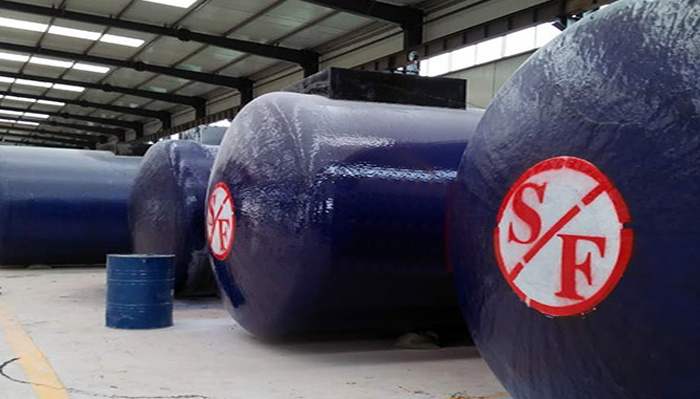Product Category
Nine methods of double-layer oil tank pressure vessel detection
Date: Apr 20, 2020

The double-layer oil tank is used as a metal pressure container for storing flammable and explosive oil products. During and after the manufacturing process, the quality inspection of the oil tank is an indispensable step.
1. Oil tank wall test: Perform a water filling test on the newly built or repaired double-layer oil tank, check whether the tank wall is tight, and conduct an appearance inspection on the oil tank wall plate and welds.
2. Double-layer oil tank wall thickness detection: materials must be admitted to the warehouse, and the oil tank must be inspected in the warehouse. The ground oil tank is mainly detected by ultrasonic waves, which has high efficiency.
3. Kerosene tightness inspection welding seam: kerosene has extremely strong penetrating power, and the weld seam on the pressure vessel tank wall is coated with kerosene for tightness inspection. Remove dirt, apply white powder emulsion, and spray kerosene on the other weld after drying. For example, after 12 hours of kerosene spray (extend the time when the temperature is low), if there are no spots on the surface of the white weld, the oil tank is welded The seam meets the requirements.
4. Tank bottom detection: The magnetic flux leakage scanning technology detects the corrosion status of the oil tank bottom plate (such as corrosion depth and area, crack length, etc.). The detection principle of this instrument is: the magnetic flux leakage scanner detects the bottom of the oil tank. When the bottom of the oil tank is defective, the magnetic field distribution will change and the sensor can detect it. The disadvantage is that some areas will be missed and the tank bottom cannot be fully tested. The bottom of the oil tank is free of debris and dry during inspection. In addition, helium gas can also be injected into the bottom of the oil tank to detect the leak point on the bottom of the tank.
5. Welding seam detection of oil tank bottom plate: When testing the bottom plate by vacuum leak test method, apply soapy water to the welding seam and cover the vacuum box for observation. 6. Measure the bottom pressure of the oil tank, calculate the weight of the medium in the pressure vessel, and conduct a double-layer oil tank leak detection. If the quality continues to decrease, there is a leak.
6. Measure the bottom pressure of the oil tank, calculate the weight of the medium in the pressure vessel, and conduct a double-layer oil tank leak detection. If the quality continues to decrease, there is a leak.
7. The leak detection is realized by detecting the change of the oil volume in the double-layer oil tank. This method is not easy to find for small leaks.
8. Add dye to the water and test the leak point by hydrostatic test. In addition, you can also listen to the sound on the tank wall or install an sonic sensor on the tank wall, set up an observation well to monitor in the tank area, and use a dipstick to perform oil level detection and leak detection.
9. When the oil tank is sending and receiving, leak detection is performed based on the difference between the actual in and out volume.
1. Oil tank wall test: Perform a water filling test on the newly built or repaired double-layer oil tank, check whether the tank wall is tight, and conduct an appearance inspection on the oil tank wall plate and welds.
2. Double-layer oil tank wall thickness detection: materials must be admitted to the warehouse, and the oil tank must be inspected in the warehouse. The ground oil tank is mainly detected by ultrasonic waves, which has high efficiency.
3. Kerosene tightness inspection welding seam: kerosene has extremely strong penetrating power, and the weld seam on the pressure vessel tank wall is coated with kerosene for tightness inspection. Remove dirt, apply white powder emulsion, and spray kerosene on the other weld after drying. For example, after 12 hours of kerosene spray (extend the time when the temperature is low), if there are no spots on the surface of the white weld, the oil tank is welded The seam meets the requirements.
4. Tank bottom detection: The magnetic flux leakage scanning technology detects the corrosion status of the oil tank bottom plate (such as corrosion depth and area, crack length, etc.). The detection principle of this instrument is: the magnetic flux leakage scanner detects the bottom of the oil tank. When the bottom of the oil tank is defective, the magnetic field distribution will change and the sensor can detect it. The disadvantage is that some areas will be missed and the tank bottom cannot be fully tested. The bottom of the oil tank is free of debris and dry during inspection. In addition, helium gas can also be injected into the bottom of the oil tank to detect the leak point on the bottom of the tank.
5. Welding seam detection of oil tank bottom plate: When testing the bottom plate by vacuum leak test method, apply soapy water to the welding seam and cover the vacuum box for observation.

7. The leak detection is realized by detecting the change of the oil volume in the double-layer oil tank. This method is not easy to find for small leaks.
8. Add dye to the water and test the leak point by hydrostatic test. In addition, you can also listen to the sound on the tank wall or install an sonic sensor on the tank wall, set up an observation well to monitor in the tank area, and use a dipstick to perform oil level detection and leak detection.
9. When the oil tank is sending and receiving, leak detection is performed based on the difference between the actual in and out volume.
Next article:
Send Your Inquiry
We not only provide a good product, but also provide high quality service. If you are interested in our products,
you can contact us in the following ways.
you can contact us in the following ways.







